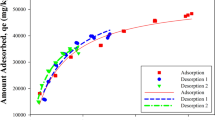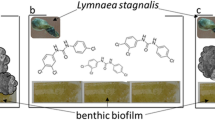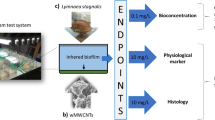Abstract
The impact of suspended particles on the bioavailability of pollutants has long been a controversial topic. In this study, adsorption of pentachlorophenol (PCP) onto a natural suspended particulate matter (SPM) and multi-walled carbon nanotubes (MWCNTs) was studied. Facilitated transports of PCP into carp by SPM and MWCNTs were evaluated by bioaccumulation tests exposing carp (Carassius auratus red var.) to PCP-contaminated water in the presence of SPM and MWCNTs, respectively. Desorption of PCP on SPM and MWCNTs in simulated digested fluids was also investigated. The results demonstrate that MWCNTs (K F = 7.99 × 104) had a significantly stronger adsorption capacity for PCP than the SPM (K F = 19.0). The presence of SPM and MWCNTs both improved PCP accumulation in the carp during the 21 days of exposure, and the 21 days PCP concentration in the carp was enhanced by 25.9 and 12.8 % than that without particles, respectively. The enhancement in bioaccumulation by MWCNTs was less than that by the SPM. Considerably more PCP was accumulated in the viscera of the fish (BCF = 519495 for SPM and 148955 for MWCNTs), and the difference in PCP concentrations between different tissues became greater with particles. PCP desorption in the simulated digestive fluids was faster than that in the background solution. Compared to MWCNTs-bound PCP, more SPM-bound PCP was desorbed, and K F of desorption for SPM was at least 4 orders of magnitude higher than that for MWCNTs, which can explain the greater enhancement in bioaccumulation in the presence of SPM. Particle-bound pollutants might pose more risk than pollutants alone.






Similar content being viewed by others
References
Arnot JA, Gobas FAPC (2004) A food web bioaccumulation model for organic chemicals in aquatic ecosystems. Environ Toxicol Chem 23:2343–2355. doi:10.1897/03-438
ATSDR (2001) Toxicological profile for pentachlorophenol [OL]. Atlanta: U.S. Department of Health and Human Services, Public Health Service, http://www.atsdr.cdc.gov/toxprofiles/tp51/pdf. Accessed September 2001
Baun A, Sørensen SN, Rasmussen RF (2008) Toxicity and bioaccumulation of xenobiotic organic compounds in the presence of aqueous suspensions of aggregates of nano-C60. Aquat Toxicol 86:379–387. doi:10.1016/j.aquatox.2007.11.019
Borcherding J, Wolf J (2001) The influence of suspended particles on the acute toxicity of 2-chloro-4-nitro-aniline, cadmium, and pentachlorophenol on the valve movement response of the zebra mussel (Dreissena polymorpha). Arch Environ Contam Toxicol 40:497–504. doi:10.1007/s002440010202
Choudhury H, Coleman J, De Rosa CT, Stara JF (1986) Pentachlorophenol: health and environmental effects profile. Toxicol Ind Health 2:483–571. doi:10.1177/074823378600200409
Cid N, Ibanez C, Palanques A, Prat N (2010) Patterns of metal bioaccumulation in two filter-feeding macroinvertebrates: exposure distribution, inter-species differences and variability across developmental stages. Sci Total Environ 408:2795–2806. doi:10.1016/j.scitotenv.2010.03.030
Cooper GS, Jones S (2008) Pentachlorophenol and cancer risk: focusing the lens on specific chlorophenols and contaminants. Environ Health Persp 116:1001–1008. doi:10.1289/ehp.11081
Fan WH, Cui MM, Liu H, Wang CA, Shi ZW, Tan C, Yang XP (2011) Nano-TiO2 enhances the toxicity of copper in natural water to Daphnia magna. Environ Pollut 159:729–734. doi:10.1016/j.envpol.2010.11.030
Fang LP, Borggaard OK, Holm PE, Hansen HCB, Cedergreen N (2011) Toxicity and uptake of tri- and dibutyltin in Daphnia magna in the absence and presence of nano-char coal. Environ Toxicol Chem 30:2553–2561. doi:10.1002/etc.649
Farah MA, Ateeq B, Ali MN, Sabir R, Ahmad W (2004) Studies on lethal concentrations and toxicity stress of some xenobiotics on aquatic organisms. Chemosphere 55:257–265. doi:10.1016/j.chemosphere.2003.10.063
Ferguson PL, Chandler GT, Templeton RC, Demarco A, Scrivens WA, Englehart BA (2008) Influence of sediment-amendment with single-walled carbon nanotubes and diesel soot on bioaccumulation of hydrophobic organic contaminants by benthic invertebrates. Environ Sci Technol 42:3879–3885. doi:10.1021/es702830b
Fisk AT, Norstrom RJ, Cymbalisty CD, Muir DCG (1998) Dietary accumulation and depuration of hydrophobic organochlorines: bioaccumulation parameters and their relationship with the octanol–water partition coefficient. Environ Toxicol Chem 17:951–961. doi:10.1897/1551-5028(1998)017<0951:DAADOH>2.3.CO;2
Gobas FAPC, Morrison HA (2000) Bioconcentration and biomagnification in the aquatic environment. In: Boethling RS, Mackay D (eds) Handbook of property estimation methods for chemicals. CRC, Boca Raton, pp 189–231
Handy RD, von der Kammer F, Lead JR, Hassellöv M, Owen R, Crane M (2008) The ecotoxicology and chemistry of manufactured nanoparticles. Ecotoxicology 17:287–314. doi:10.1007/s10646-008-0199-8
Hedberg J, Lundin M, Lowe T, Blomberg E, Wold S, Odnevall Wallinder I (2012) Interactions between surfactants and silver nanoparticles of varying charge. J Colloid Interf Sci 369:193–201. doi:10.1016/j.jcis.2011.12.004
Keith LH, Telliard W (1979) ES&T Special Report: Priority pollutants: I—a perspective view. Environ Sci Technol 13:416–423. doi:10.1021/es60152a601
Knauer K, Sobek A, Bucheli TD (2007) Reduced toxicity of diuron to the freshwater green alga Pseudokirchneriella subcapitata in the presence of black carbon. Aquat Toxicol 83:143–148. doi:10.1016/j.aquatox.2007.03.021
Koelmans AA, Jonker MTO, Cornelissen G, Bucheli TD, Van Noort PCM, Gustafsson O (2006) Black carbon: the reverse of its dark side. Chemosphere 63:365–377. doi:10.1016/j.chemosphere.2005.08.034
Kondo T, Yamamoto H, Tatarazako N, Kawabe K, Koshio M, Hirai M, Morita M (2005) Bioconcentration factor of relatively low concentrations of chlorophenols in Japanese medaka. Chemosphere 61:1299–1304. doi:10.1016/j.chemosphere.2005.03.058
Lin SC, Blankschtein D (2010) Role of the bile salt surfactant sodium cholate in enhancing the aqueous dispersion stability of single-walled carbon nanotubes: a molecular dynamics simulation study. J Phys Chem B 114:15616–15625. doi:10.1021/jp1076406
Long RQ, Yang RT (2001) Carbon nanotubes as superior sorbent for dioxin removal. J Am Chem Soc 123:2058–2059. doi:10.1021/ja003830l
Lou LP, Luo L, Yang Q, Cheng QH, Xun B, Xu SH, Chen YX (2012) Release of pentachlorophenol from black carbon-inclusive sediments under different environmental conditions. Chemosphere 88:598–604. doi:10.1016/j.chemosphere.2012.03.039
Lu F, Zhang SH, Zheng LQ (2012) Dispersion of multi-walled carbon nanotubes (MWCNTs) by ionic liquid-based phosphonium surfactants in aqueous solution. J Mol Liq 173:42–46. doi:10.1016/j.molliq.2012.06.012
Mackay D, Fraser A (2000) Bioaccumulation of persistent organic chemicals: mechanisms and models. Environ Pollut 110:375–391. doi:10.1016/S0269-7491(00)00162-7
Mason RP, Laporte JM, Andres S (2000) Factors controlling the bioaccumulation of mercury, methylmercury, arsenic, selenium, and cadmium by freshwater invertebrates and fish. Arch Environ Contam Toxicol 38:283–297. doi:10.1007/s002449910038
Matsuura K, Saito T, Okazaki T, Ohshima S, Yumura M, Iijima S (2006) Selectivity of water-soluble proteins in single-walled carbon nanotube dispersions. Chem Phys Lett 429:497–502. doi:10.1016/j.cplett.2006.08.044
Millward RN, Bridges TS, Ghosh U, Zimmerman JR, Luthy RG (2005) Addition of activated carbon to sediments to reduce PCB bioaccumulation by a polychaete (Neanthes arenaceodentata) and an amphipod (Leptocheirus plumulosus). Environ Sci Technol 39:2880–2887. doi:10.1021/es048768x
Oleszczuk P, Pan B, Xing BS (2009) Adsorption and desorption of oxytetracycline and carbamazepine by multiwalled carbon nanotubes. Environ Sci Technol 43:9167–9173. doi:10.1021/es901928q
Salam MA, Burk RC (2010) Thermodynamics and kinetics studies of pentachlorophenol adsorption from aqueous solutions by multi-walled carbon nanotubes. Water Air Soil Poll 210:101–111. doi:10.1007/s11270-009-0227-1
Shen MH, Xia XH, Wang F, Zhang P, Zhao XL (2012) Influences of multiwalled carbon nanotubes and plant residue chars on bioaccumulation of polycyclic aromatic hydrocarbons by Chironomus plumosus larvae in sediment. Environ Toxicol Chem 31:202–209. doi:10.1002/etc.722
Sun H, Zhang XZ, Zhang ZY, Chen YS, Crittenden JC (2009) Influence of titanium dioxide nanoparticles on speciation and bioavailability of arsenite. Environ Pollut 157:1165–1170. doi:10.1016/j.envpol.2008.08.022
Tan C, Fan WH, Wang WX (2011) Role of titanium dioxide nanoparticles in the elevated uptake and retention of cadmium and zinc in Daphnia magna. Environ Sci Technol 46:469–476. doi:10.1021/es202110d
Tao S, Liu C, Dawson R, Cao J, Li B (1999) Uptake of particulate lead via the gills of fish (Carassius auratus). Arch Environ Contam Toxicol 37:352–357. doi:10.1007/s002449900524
Tao S, Lu Y, Zhang DY, Yang YF, Yang Y, Lu XX, Sai DJ (2009) Assessment of oral bioaccessibility of organochlorine pesticides in soil using an in vitro gastrointestinal model. Environ Sci Technol 43:4524–4529. doi:10.1021/es900188c
Tian SY, Zhu LY, Bian JN, Fang SH (2012) Bioaccumulation and metabolism of polybrominated diphenyl ethers in carp (Cyprinus carpio) in a water/sediment microcosm: Important role of particulate matter exposure. Environ Sci Technol 46:2951–2958. doi:10.1021/es204011k
Vasiluk L, Pinto LJ, Walji ZA, Tsang WS, Gobas FAPC, Eickhoff C, Moore MM (2007) Benzo[a]pyrene bioavailability from pristine soil and contaminated sediment assessed using two in vitro models. Environ Toxicol Chem 26:387–393. doi:10.1897/06-343R.1
Veith GD, DeFoe DL, Bergstedt BV (1979) Measuring and estimating the bioconcentration factor of chemicals in fish. J Fish Res Board Can 36:1040–1048. doi:10.1139/f79-146
Wang JF, Gerlach JD, Savage N, Cobb GP (2013) Necessity and approach to integrated nanomaterial legislation and governance. Sci Total Environ 442:56–62. doi:10.1016/j.scitotenv.2012.09.073
Wang ZY, Zhao J, Song L, Mashayekhi H, Chefetz B, Xing BS (2011) Adsorption and desorption of phenanthrene on carbon nanotubes in simulated gastrointestinal fluids. Environ Sci Technol 45:6018–6024. doi:10.1021/es200790x
Wenseleers W, Vlasov II, Goovaerts E, Obraztsova ED, Lobach AS, Bouwen A (2004) Efficient isolation and solubilization of pristine single-walled nanotubes in bile salt micelles. Adv Funct Mater 14:1105–1112. doi:10.1002/adfm.200400130
Yang K, Xing BX (2007) Desorption of polycyclic aromatic hydrocarbons from carbon nanomaterials in water. Environ Pollut 145:529–537. doi:10.1016/j.envpol.2006.04.020
Yang WC, Gan JY, Hunter W, Spurlock F (2006) Effect of suspended solids on bioavailability of pyrethroid insecticides. Environ Toxicol Chem 25:1585–1591. doi:10.1897/05-448R.1
Yang WW, Li Y, Miao AJ, Yang LY (2012) Cd2+ toxicity as affected by bare TiO2 nanoparticles and their bulk counterpart. Ecotox Environ Safe 85:44–51. doi:10.1016/j.ecoenv.2012.08.024
Zhang XZ, Sun HW, Zhang ZY, Niu Q, Chen YS, Crittenden JC (2007) Enhanced bioaccumulation of cadmium in carp in the presence of titanium dioxide nanoparticles. Chemosphere 67:160–166. doi:10.1016/j.chemosphere.2006.09.003
Zheng WW, Yu H, Wang X, Qu WD (2012) Systematic review of pentachlorophenol occurrence in the environment and in humans in China: not a negligible health risk due to the re-emergence of schistosomiasis. Environ Int 42:105–116. doi:10.1016/j.envint.2011.04.014
Zhou PJ, Xie LL, Liu LJ, Li J, He F, Wu ZB (2007) Studies on the adsorption equilibrium and kinetics of pentachlorophenol on suspended particulate matter of Donghu Lake water. Fresen Environ Bull 16:856–860
Zhu XS, Zhou J, Cai ZH (2011) TiO2 nanoparticles in the marine environment: Impact on the toxicity of tributyltin to abalone (Haliotis diversicolor supertexta) embryos. Environ Sci Technol 45:3753–3758. doi:10.1021/es103779h
Acknowledgments
This work was supported by the National Natural Science Foundation of China (No. 41225014 and No. 41073087).
Author information
Authors and Affiliations
Corresponding author
Additional information
Responsible editor: Philippe Garrigues
Rights and permissions
About this article
Cite this article
Sun, H., Ruan, Y., Zhu, H. et al. Enhanced bioaccumulation of pentachlorophenol in carp in the presence of multi-walled carbon nanotubes. Environ Sci Pollut Res 21, 2865–2875 (2014). https://doi.org/10.1007/s11356-013-2234-4
Received:
Accepted:
Published:
Issue Date:
DOI: https://doi.org/10.1007/s11356-013-2234-4




